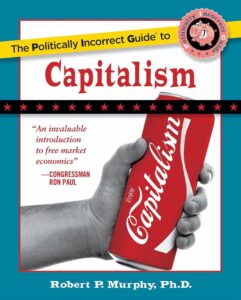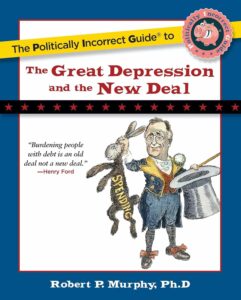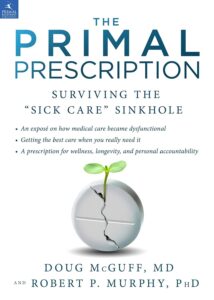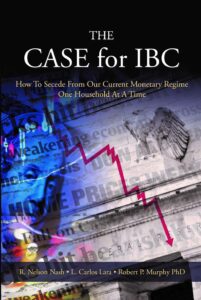Quick Note on Miss California and the Constitution
I am in a hotel room in North Dakota doing a radio interview for my book. (It’s on a commercial break.) I just wanted to blog this quickly before I forget. Did you hear Miss California’s statement at the press conference where Donald Trump said she could keep her crown?
I don’t have time to dig up the exact words, but she said something along the lines of her uncle (grandfather?) fighting in Korea to defend our freedoms. And that the Constitution gave us freedom of speech, and it was crazy that in America today, people like her could be persecuted for speaking her beliefs.
[UPDATE: Here is the video. My original recollection was off; her grandfather had fought under Patton in World War II. But just watch it for 60 seconds and you’ll see what I mean. She seems to think the Constitution protects the right of someone to say she believes marriage is between a man and a woman, and then not have others criticize her for saying that. No, the Constitution has nothing to do with that, and her grandfather should have taught her better.]
I’m sorry young lady, but your relative didn’t do a good job explaining to you what the Constitution does. It doesn’t put limits on what beauty pageants can ask of their candidates. Just like the Constitution doesn’t protect Don Imus’ “right” to make an ass of himself on the air.
What really stunned me was not that Miss California would play that card, but that “great Americans” and big fans of American history and the Founding Fathers (like Sean Hannity) played the excerpts of her speech without even mentioning, “Of course folks, she’s being a little off here, but you get the idea…”
More Magical "Seasonal Adjustment" to the CPI
Hmm the headline says no CPI inflation in April. Yet as usual, prices did in fact rise, but they were seasonally adjusted away. According to the first sentence of the BLS press release: “The Consumer Price Index for All Urban Consumers (CPI-U) increased 0.2 percent in April before seasonal adjustment, the Bureau of Labor Statistics of the U.S. Department of Labor reported today.”
So to make sure we all understand, the actual, unadjusted CPI has increased four straight months in a row; see for yourself by scrolling to the bottom here. From Dec 2008 to Apr 2009, unadjusted CPI rose from 210.228 to 213.240. That’s a 1.4% increase over four months, which works out to an annualized price inflation rate of 4.3%.
On the other hand, if you look at the seasonally adjusted CPI figures, the annualized price inflation from Dec 08 to Apr 09 is only 1.6%.
Got that? If you look at how much prices actually changed, they are rising at a 4.3% annualized rate (from December to April). But if you just read the headlines on CNBC, you would think prices are rising only at a 1.6% annualized rate.
If this were over a two-week period, OK fine. But this discrepancy between actual and “seasonal” is now over a four-month period. That’s a big season, eh?
Remember what the principle of a seasonal adjustment is: For the above numbers to make sense, the BLS has to say, “Sure, prices always tend to rise a bunch in the first third of the year, but then they tend to fall later on.” So that means even if prices are flat in the coming months, at some point the BLS is going to have to bump up the official inflation rate.
Unless of course you think the BLS is manipulating the numbers to keep the public worried about a “deflationary spiral.” After all, you can’t justify pumping hundreds of billions into the financial markets–and saying things like, “Don’t worry, we’ll take it out once prices begin rising”–if the annualized inflation rate is already at least 50% higher than the top of the Fed’s “comfort zone.”
On this topic, see Scott Sumner’s great post. He’s wrong of course, but beautifully so.
Scott Sumner on Krugman
I will be at the North Dakota Free Market Forum for the next few days, so blogging will be at a minimum. In the meantime, remember a while back when I said Scott Sumner was my new favorite blogger, and some of you pooh-poohed me because of his position on business cycles? You have to look beyond the theoretical errors and grasp the essence of the blogger. Check this out:
Over the last few months I have had a chance to closely examine many of Krugman’s recent and past writings on fiscal and monetary policy. One thing that I notice is that Krugman is very skilled at making an argument. He can use the same basic model to make either monetary or fiscal policy seem like the only reasonable option. All that is required is that one tweak the assumptions in such a way that the less favored policy seems either undesirable or infeasible. So my message is this—don’t let anyone (including me) bully you into thinking that your policy instincts are wrong, until you have closely examined the assumptions that underlie each side of the debate. All this drivel in the blogoshere about velocity, multipliers, liquidity traps, Ricardian equivilence, budget constraints, etc, etc, are merely verbal tools that can be wielded to achieve any desired outcome. It’s an insiders game. The real battle is elsewhere.
Ah, I can spot talent. I knew this guy was worth watching.
And don’t worry, kids: Sumner seems intellectually honest enough that when nominal GDP rises at more than 7% per year in 2010,* while CPI rises by more than 10%, he will concede that he needs to go back to the drawing board. Not saying he will get a tatoo of Rothbard on his left arm, but he will realize he has some ‘splaining to do.
* Not an official prediction.
The Fed as Crime Fighter?
In an otherwise interesting post regarding Fed officials’ sympathy for banks to engage in “regulatory capital arbitrage,” Arnold Kling writes:
The thinking [by Fed officials] was that the Basel capital accords required banks to hold too much capital for mortgages (this was probably true). Accordingly, the article [by a Fed official] takes a sympathetic view of regulatory arbitrage. In retrospect, this is a bit like watching a movie in which a jailer becomes sympathetic to a prisoner, when we know that the prisoner is eventually going to escape and go on a crime spree.
In the comments I wrote:
Except, the crime doesn’t occur until the jailer looks at all the bad investments the escaped con makes, and then the jailer robs the whole neighborhood to pay off the bad loans.
Austrian Business Cycle Theory and the "Rational Expectations" Objection
The most typical objection to the ABCT from mainstream economists is that it apparently violates “rational expectations.” Loosely: Why don’t businesspeople learn to be careful when the Fed lowers interest rates?
Here [pdf] is an excerpt of a paper I wrote while teaching at Hillsdale. It has all the Bayesian bells and whistles, and gives a pretty neat model (or so I thought) of the Mises-Hayek story with all the Greek letters you could want. The referees at the Austrian journals thought otherwise, but in retrospect there was some extraneous stuff I put in the critique of Carilli-Dempster (which I’ve removed from this excerpt).
Anyway, this is how I think central banks make market economies more boom-prone, and also why they yield more sluggish growth. Yes, entrepreneurs do try to anticipate the Fed’s moves, but the presence of the Fed makes interest rates less informative of underlying scarcity. So you get more booms than you otherwise would, and you also get more missed opportunities than you otherwise would. Hence, lower average growth in the long run, plus the occasional boom-slump thrown in for good measure.
Busting the Myth of Green Jobs
The tech guy at IER managed to isolate my 6-minute intro at the Heritage Foundation’s recent panel on “green jobs.” I don’t take a stand here on the science; I merely point out that government constraints on business won’t make them more profitable (as Obama et al. are claiming).
Star Trek: Get Me to Sickbay, I’m Gonna Puke
I’m sorry kids, I was not happy with the latest Star Trek, and I was a massive Trek geek in junior high / first portion of high school. (Don’t ask me how many dates I had.) I think the TNG episode where LaForge accidentally has the Holodeck create Moriarity with his slip of the tongue is a work of science fiction art. And oh my gosh, when I was a little kid, half of my playing involved me running around the house “on” the bridge of the original series’ Enterprise.
So I’m sorry to say that I cannot endorse the movie I saw last night. The casting was very good, and the kid playing Kirk was perfect. But COME ON–can’t they have some sort of Implausibility Veto when it comes to these scripts?
And don’t tell me, “Ha ha, it’s a movie about faster-than-light space travel and teleportation devices, and here’s Bob whining about plausibility.” There’s a difference between (a) a script involving suspense when a ship is attacked by photon torpedoes, and (b) a script involving suspense when a Federation officer tries to mow somebody’s lawn with photon torpedoes.
I don’t want to give spoilers on the front page, so in the comments I’ll share my pain with those of you who saw this joke.
How Much Inflation Is the Market Forecasting?
The strongest argument against those of us who are warning of potentially massive price inflation is that the bond market is apparently disagreeing with us. For example, yields on 5-year Treasurys (as of this writing) are about as low as they have been in the series’ history at FRED, which certainly doesn’t seem consistent with a decent probability of, say, 10%+ price inflation anytime soon.
Now the worry-warts among us can offer all sorts of explanations for this. The Fed is printing up new money (partly) to purchase Treasurys, and so it’s not surprising that the yields might be temporarily held down. It’s also possible that the markets are in such disarray that the (virtually) riskless real return on US Treasurys has fallen into negative territory, such that even an expected annual price inflation of 5% over the next few years is showing up as a very low nominal yield.
In theory, the cleanest way to back out the market’s actual inflation forecast is to contrast the TIPS yield with nominal yields. The Treasury Inflation Protected Security (TIPS) offers the investor protection against price inflation by adjusting the nominal face value of the bond according to changes in the CPI. So the yield on a TIPS bond (in theory) compensates the investor for the pure deferment of purchasing power, stripping away the inflation risk.
To do it correctly, you would want to correct for the differences in liquidity between standard and TIPS markets, etc., but I think most people use a simple rule of thumb. They take the nominal Treasury yield and subtract the TIPS yield (for the same maturity) and call the result the “market’s forecast” of annualized inflation over the life of the bonds.
In April 2009, the difference between the average monthly 5-year Treasury yield and the 5-year TIPS yield was a mere 0.75%, leading people like Scott Sumner to confidently say that inflation is not a threat. In other words, the implication is that “the market” is only forecasting average annual 0.75% CPI increases over the next five years.
But is that right? Unfortunately the TIPS contracts were only introduced in 2003, so we don’t have that much time to contrast implied forecasts with actual results. But in the table below, I give the limited data points that we have:

If you ask 85 economists to interpret the above table, you’ll probably get 37 different answers. My own guess is that (for whatever reason) the “TIPS forecast” systematically understates expected inflation rates. I am not saying bond traders were dumb in the first half of 2003; rather I am saying that there are probably reasons that the two numbers won’t actually be equal, even if traders had perfect foresight.
When I look at that table, I conclude that the “normal” markup should be about 150 basis points from the spread, to get the true market forecast. I think the reason the “underforecast” fell so much was not that the market got smarter in early 2004, but rather that traders failed to anticipate the outright price deflation in late 2008, which ate into the standard markup.
Thus, I think the current spread of 0.75% means that the market “forecast” of 5-year average inflation is above 2%. That’s still a lot lower than what I personally am predicting, but my point in this post is that people citing the information from TIPS never justify that tool. With the only results we have available (unless they’ve done TIPS-type contracts in other countries for longer periods?), it looks like the nominal-TIPS spread isn’t a very reliable indicator of inflation at all. Not only is it systematically different from 0, but it swings wildly.







Recent Comments